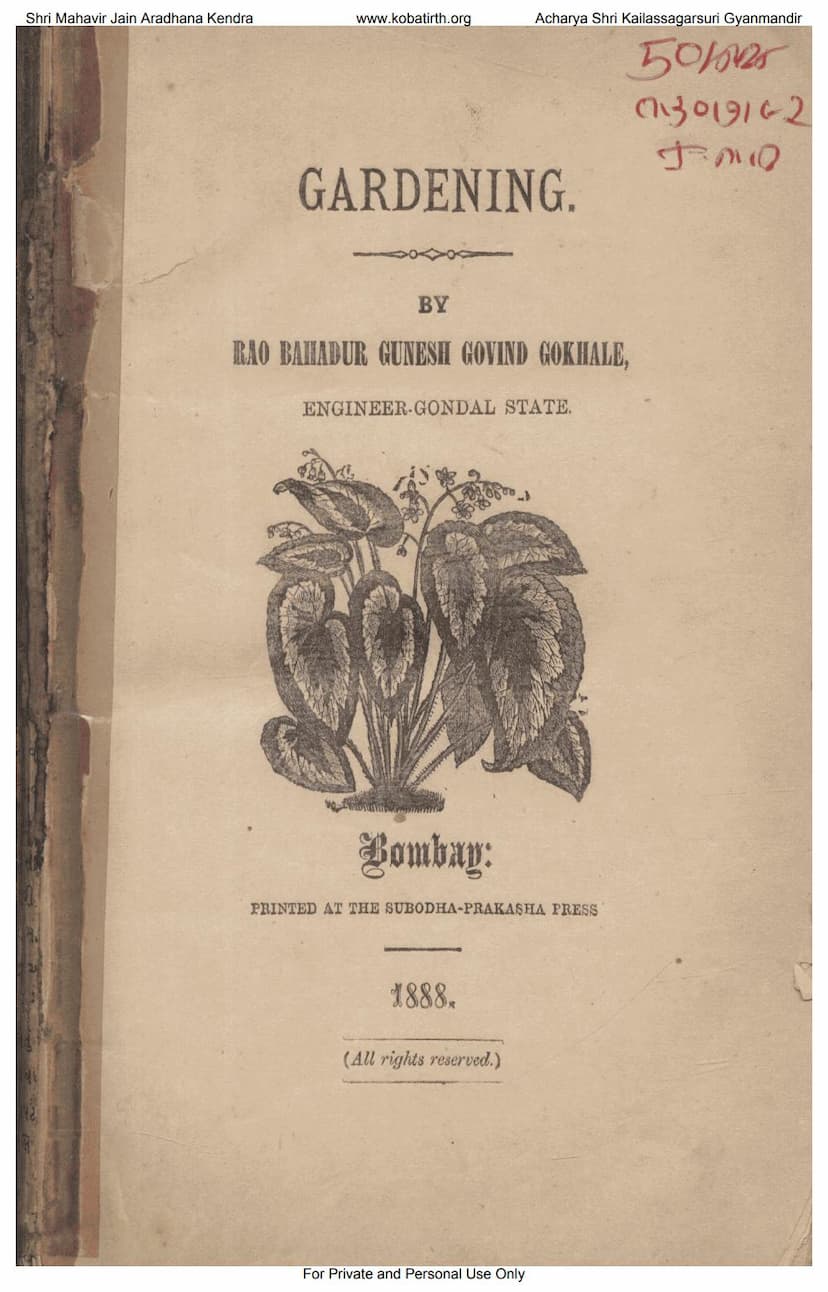Bagichanu Pustak
Added to library: September 1, 2025

Summary
Here's a comprehensive summary of the Jain text "Bagichanu Pustak" by Ganesh G Gokhle:
Title: Bagichanu Pustak (A Book of Gardens) Author: Rao Bahadur Gunesh Govind Gokhale, Engineer-Gondal State Publisher: Printed at the Subodha-Prakasha Press, Bombay Year: 1888
Overall Purpose: "Bagichanu Pustak" is a foundational guide to gardening, written in Gujarati by Gunesh Govind Gokhale. The author, drawing from his ten years of experience in laying out state and municipal gardens in Gondal, aimed to provide a comprehensive resource for Gujarati speakers who had a growing interest in horticulture. The book covers a wide range of topics, from basic botanical principles to detailed instructions on planting, cultivation, propagation, and pest management.
Key Themes and Content:
-
Introduction to Botany: The initial chapters lay the groundwork by explaining basic botanical concepts, differentiating between plants and animals, and detailing the essential elements plants need to survive (air, water, light, heat, soil). It discusses the lifespan of plants (annuals, biennials, perennials) and their geographical distribution.
-
Gardening Basics: The book delves into practical aspects of gardening, including:
- Site Selection and Soil: Guidance on choosing appropriate locations for gardens, considering soil types (alluvial, black, sandy, red, yellow), and how to improve soil quality.
- Manures and Fertilizers: A detailed discussion on various types of fertilizers, both general (like cow dung) and specific (like saltpeter), and methods for preparing them, including sewage or night-soil manure (poudrette). It emphasizes the importance of proper manure preparation and application for plant health and yield.
-
Propagation Methods: A significant portion of the book is dedicated to various techniques for plant propagation:
- Seeds: How to select, test, sow, and preserve seeds, including specific methods for different seed types (hard-shelled, those needing immediate sowing).
- Cuttings (Kalam): Detailed instructions on taking and planting cuttings from different types of plants, specifying the best seasons and methods for success.
- Layering (Dab): Explaining how to induce roots on branches while they are still attached to the parent plant.
- Grafting (Ankh Chadhava/Chapadhavu/Khuti): A thorough exploration of various grafting techniques, including tongue grafting, whip grafting, side grafting, and bridge grafting, with an emphasis on successful union of scion and rootstock.
- Budding (Ankh Chadhavava): Step-by-step instructions on the process of bud grafting.
- Division of Suckers: How to propagate plants from the offshoots or suckers that grow from the base of the parent plant.
- Leaf Propagation: Demonstrating how to grow new plants from leaf cuttings.
-
Plant Management: The book covers essential plant care practices:
- Pruning (Serava): Techniques for pruning branches and roots to improve plant shape, fruit yield, and overall health.
- Watering: Guidance on appropriate watering techniques for potted plants and general garden plants, emphasizing the importance of timing and quantity.
- Hybridization (Navi Taredna Zado Karvani Rit): An introduction to the concept of cross-pollination to create new plant varieties.
-
Pest and Disease Management: Chapters are dedicated to identifying and controlling common garden pests and diseases, offering natural remedies and preventative measures.
-
Specific Plant Profiles: The book provides detailed information on a wide variety of fruit trees, flowering plants, and ornamental trees, including:
- Fruits: Banana (Khel), Coconut (Narliol), Mango (Amba), Pineapple (Ananas), Pomegranate (Dadmi), Bilimbi (Bilambi), Loquat (Lokat), Guava (Jamphal), Tamarind (Imli - including Red Tamarind), Oranges (Narangi - including Sweet Lime, Sour Lime, Citron, Pomelo), Cashew (Kaju), Jujube (Bor), Tomato (Tomato), Peach (Samalu), Fig (Anjir), Pomegranate (Dadmi), Gooseberry (Amala), Karonda (Karamadi), Indian Almond, Sugar Palm, Betel Nut, Jackfruit (Fanas), Custard Apple (Sitaphal), Ramphal, Sugar Apple (MAM Phal), Bael (Bilimbi), Banana (Khel), Palmyra Palm (Tad), Walnut (Valnat), Apricot (Jaldaru), and others.
- Flowers and Ornamentals: Rose (Gulab), Jasmine (Jasni), Crinum, Oleander (Kareru), Gardenia (Gandharaj), Balsam (Galamandi), Zinnia, Marigold (Suraj Phul), Nasturtium, Petunia, etc.
- Other Useful Plants: Cinnamon (Taj), Camphor (Kapoor), Bamboo (Vansh), and various other trees and shrubs.
-
Horticultural Practices: The book also touches upon more advanced techniques such as grafting, budding, and the use of conservatories or ferneries.
-
Dedication: The work is respectfully dedicated to H.H. Sir Bhagvatsinhjee, Thakore Saheb of Gondal, acknowledging his patronage and the furlough granted for the author's health, which enabled him to complete the book.
Significance: "Bagichanu Pustak" was a pioneering work in Gujarati horticulture literature at the time of its publication. It provided practical, accessible knowledge to a generation eager to cultivate gardens, blending traditional Indian gardening practices with contemporary improvements. The author's personal experience and consultation of English authors reflect a blend of local expertise and broader horticultural understanding. The book's comprehensive nature, covering a vast array of plants and techniques, made it an invaluable resource for aspiring gardeners in the region.